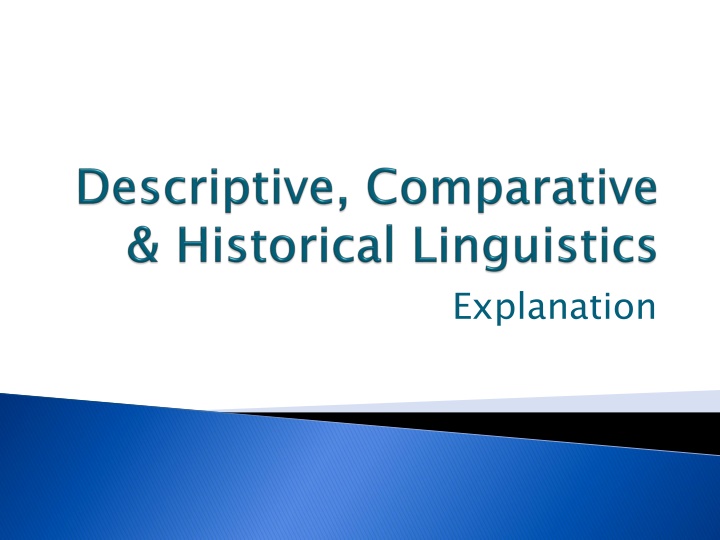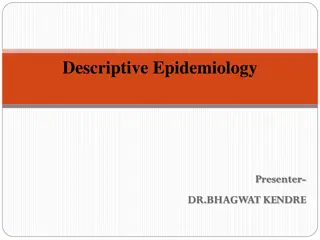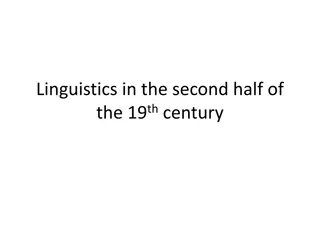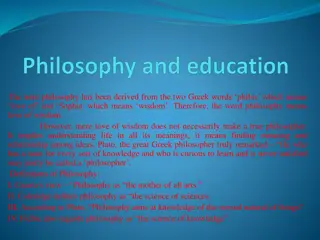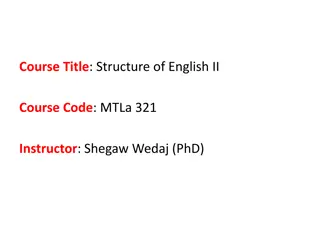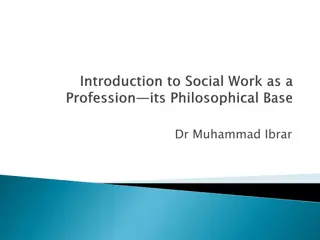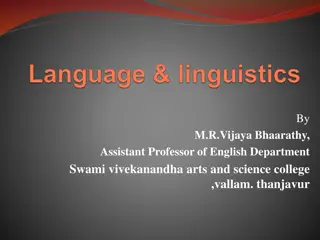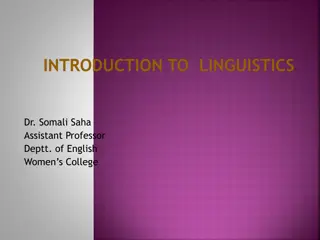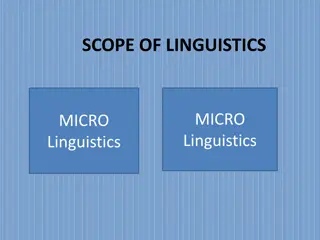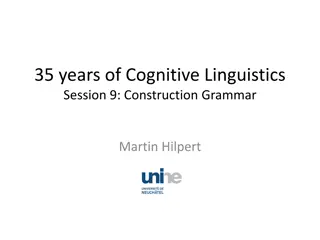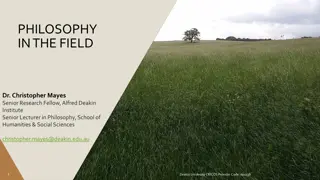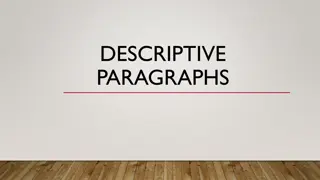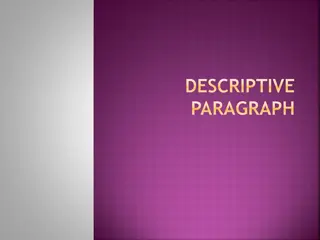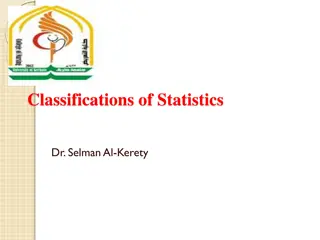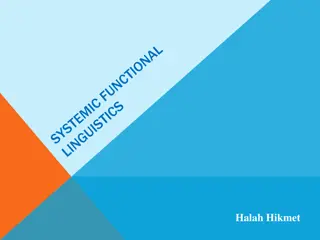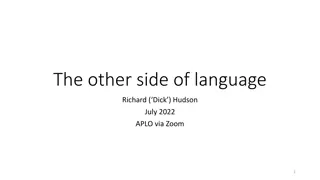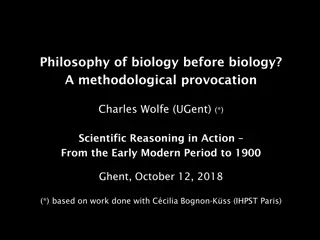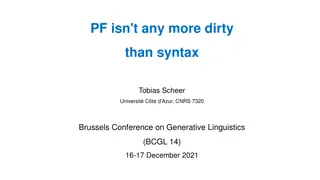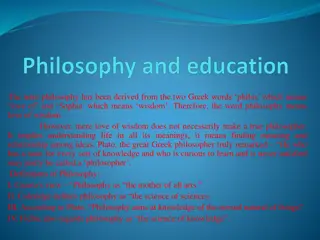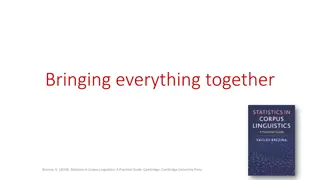Evolution of Linguistics: From Philosophy to Descriptive Study
Linguistics has evolved significantly from being a branch of philosophy to a distinct field called Descriptive Linguistics. It now focuses on studying language in itself rather than in relation to other disciplines, aiming to describe and analyze the structure and operation of languages at different levels such as phonology, grammar, and semantics. Descriptive Linguistics is a fundamental aspect of understanding language, emphasizing a structural approach in its study.
Download Presentation

Please find below an Image/Link to download the presentation.
The content on the website is provided AS IS for your information and personal use only. It may not be sold, licensed, or shared on other websites without obtaining consent from the author.If you encounter any issues during the download, it is possible that the publisher has removed the file from their server.
You are allowed to download the files provided on this website for personal or commercial use, subject to the condition that they are used lawfully. All files are the property of their respective owners.
The content on the website is provided AS IS for your information and personal use only. It may not be sold, licensed, or shared on other websites without obtaining consent from the author.
E N D
Presentation Transcript
-Status of linguistics now and before 20th century - Known as philosophy in the past, now new name Linguistics - It studies language in itself rather than in relation to other areas (philosophy or history) - It is self enclosed & autonomous system
Necessity to define autonomy- to study language system Now we acknowledge that linguistics, being a distinct area of study, is also linked to other disciplines there are over-lapping areas
Describe language Study the nature of language Establish a theory of language Linguistics aims at studying the components of Language system to arrive at explanatory statement on how the system works
In modern linguistics the activity of describing the language system is the most important. SO Modern Linguistics is known as Descriptive Linguistics
Robins (1985, p. 3) says: Descriptive Linguistics is concerned with the description and analysis of the ways in which a language operates and is used by a given set of speakers at a given time. The time referred to may be the present or the past. The language is described irrespective of what preceded it or may follow it
Descriptive language is the fundamental aspect of the study of language It is different from prescriptive language because it deals with how language actually works rather than how it should be; in itself rather than in relation to other languages. In descriptive language we describe language systematically at all levels i.e phonology, grammar and semantics.
We describe the structure of language Descriptive Linguistics is based on structural approach.
Historical Linguistics Robins (1985, p.5) explains: Historical Linguistics is the study of the development in language in the course of time, the ways in which languages change from period to period and of the causes and results of such changes It must be based on a description of two or more stages in the development of the language being studied.
Ferdinand D Saussure (1916) gave two terms, Synchronic and Diachronic They distinguish between the description of a stage of a language at a given time and description of the changes that take place during the passage of time
A synchronic description is non-historical, a diachronic description traces the historical development of a language (Lyons, 1981, p.219) Changes in English from old English to Middle English to Modern English Diachronic or historical study Structure of English as it exists today and without reference to its past shape- Synchronic study
Comparative Linguistics two languages are compared - History of two languages is compared to discover historical relation between two languages in comparative historical study (or philosophy) - Such a work dominant in 19thcentury
Modern languages have descended from ancient language so, comparative historical describes this process of evolution as well as well as similarities in the process of change. The comparative and historical methods based on discovering relationships between languages
L Proto- language (Parent language) L1 & L2 Sister languages (developed later) All these taken together form a language family e.g Proto Indo European Latin Greek German Sunskrit
Proto language no longer exists It is reconstructed but not easy to trace similarities between languages Historical & Comparative linguists make lists of words from different languages. Then sound similarities and occurrence of sounds at different positions compared
Linguists find sound correspondence and build cognates. A cognate is a word related genetically to other words that together form set of cognates descending from proto language e.g brother (English) bharata (Sunskrit) cognates. frater (Latin)
A sound similarity in each cognat. They are cognates belonging to a set relating to a word which may have existed in proto- Indo - European language Comparative linguists try to construct cognat sets & reconstruct proto forms to talk about the changes that have occurred in the development of languages
Comparative linguists study language changes, formation & development of languages This is not possible without describing the related languages comes in Descriptive linguistics When descriptive linguists study two or more languages that exist at a particular time, they study language changes
Two or more descriptions of languages contrasted (Tamil & Hindi) Contrastive Linguistics (based on synchronic description i.e. it s not historical)
Modern Linguistics is: - mainly descriptive because it attempts to describe fully and accurately the structure of language as it exists at a given time. - Synchronic study of language - An effort to describe language at all levels (Phonological, morphological, syntactic, semantic & discourse level)
